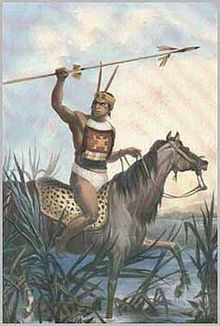- Charrúa people
-
History of Uruguay 
This article is part of a seriesEarly History Charrúa people British invasions Federal League Cisplatina Thirty-Three Orientals Treaty of Montevideo Independent State War of the Triple Alliance Revolution of the Lances Battle of Masoller 20th Century Batllism 1933 coup d'etat Neo-Batllism Military Regime Tupamaros 1973 coup d'etat Civic-military dictatorship (1973-1985) Modern Uruguay Mercosur 2004 Elections Politics of Uruguay
Uruguay Portal
v · indigenous people of southern South America in the area today known as Uruguay and southern Brazil. They were a nomadic people that sustained themselves through fishing and foraging. They did not build permanent structures, living instead in tents.Charrúa people are believed to have killed Spanish explorer Juan Díaz de Solís during his 1515 voyage up the Río de la Plata. Following the arrival of European settlers, the Charrúa were progressively killed and integrated into the prevailing colonial cultures. Most of the remaining ones were massacred at Salsipuedes (literally "Get-out-if-you-can") Creek in 1831 by a group led by Bernabé Rivera, nephew of Fructuoso Rivera who later became the first president of Uruguay, after they were invited to a meeting and ambushed. Only a few escaped this massacre. Four of them were taken to France in 1833, including Tacuabé, to whom there is a monument in Montevideo, Uruguay.
Not much is known about the Charrúa due to their eradication at an early time in Uruguayan history. The only surviving documents that concern the Charrúa are those of Spanish explorers.
Uruguayans refer to themselves as "charrúas" when in the context of a competition or battle against a foreign contingent. In situations in which Uruguayans display bravery in the face of overwhelming odds, the expression "garra charrúa" (Charrúan rage) is used to refer to victory in the face of certain defeat.
After Salsipuedes, the Charrúa effectively ceased to exist as a people. It is said that there are no full-blooded Charrúa remaining, though physical traces may be found among Uruguay's minority mestizo population. According to the Argentine census of 2001, there are 676 Charrúa (the majority of whom are of mixed ancestry) living in the province of Entre Ríos.
The Uruguay national football team is nicknamed "Los Charrúas" and a local rugby side in Porto Alegre are also named after the nation (see: Charrua Rugby Clube)
Charrua is also a name of a Brazilian military tank for troops transportation.
See also


This South American history-related article is a stub. You can help Wikipedia by expanding it.v · Categories: - Uruguayan society
- History of South America
- Indigenous peoples in Argentina
- History of Uruguay
- Indigenous peoples of the Southern Cone
- Uruguay stubs
- Pre-Columbian era stubs
- South American history stubs
Wikimedia Foundation. 2010.
Look at other dictionaries:
Charrua — The Charrúa were an indigenous people of southern South America in the area today known as Uruguay, northeastern Argentina and southern Brazil. They were a nomadic people that sustained themselves through fishing and foraging. They did not build… … Wikipedia
charrua — chəˈrüə noun (plural charrua or charruas) Usage: usually capitalized Etymology: Spanish charrúa; of American Indian origin 1. a. : an extinct Indian people of Uruguay and adjacent parts of Argenti … Useful english dictionary
Charrúa — ▪ people South American Indians who inhabited the grasslands north of the Río de la Plata in a territory somewhat larger than modern Uruguay. Little is known of their language. Linguistically related groups, including the Yaró, Guenoa,… … Universalium
Estadio Charrúa — is a multi use stadium in Montevideo, Uruguay. It is currently used mostly for football matches. The stadium holds 12,000 people … Wikipedia
Minuane people — Minuane were one of the indigenous tribes of Uruguay and Brazil (specially in the state of Rio Grande do Sul). They were related to the other tribes in the area like Charrua and Guenoa. Nowadays no one claims Minuane ancestry in Uruguay or in… … Wikipedia
Charruan languages — Charruan Ethnicity: Charrúa people Geographic distribution: Uruguay and Entre Ríos Province, Argentina Linguistic classification: Mataco–Guaicuru ? Charruan … Wikipedia
Military history of South America — The Battle of Chacabuco, 1817, during the Chilean War of Independence, a war often fought across harsh and difficult terrain. The military history of South America can be divided into two major periods pre and post Columbian divided by the… … Wikipedia
Junín, Buenos Aires Province — Junín Downtown Junín … Wikipedia
Tupamaros — This article is about the Uruguayan guerrilla group. For the Peruvian guerrilla group, see Túpac Amaru Revolutionary Movement. For the Venezuelan group, see Tupamaro (Venezuela). Flag of the Tupamaros National Liberation Movement … Wikipedia
Civic-military dictatorship of Uruguay — History of Uruguay This article is part of a series Early History … Wikipedia
18+© Academic, 2000-2025- Contact us: Technical Support, Advertising
Dictionaries export, created on PHP, Joomla, Drupal, WordPress, MODx.Share the article and excerpts
Charrúa people
- Charrúa people
-
History of Uruguay 
This article is part of a seriesEarly History Charrúa people British invasions Federal League Cisplatina Thirty-Three Orientals Treaty of Montevideo Independent State War of the Triple Alliance Revolution of the Lances Battle of Masoller 20th Century Batllism 1933 coup d'etat Neo-Batllism Military Regime Tupamaros 1973 coup d'etat Civic-military dictatorship (1973-1985) Modern Uruguay Mercosur 2004 Elections Politics of Uruguay
Uruguay Portal

